Amphiphilic Cationic Triscyclometalated Iridium(III) Complex-Peptide Hybrids Induce Paraptosis-like Cell Death of Cancer Cells via an Intracellular Ca2+-Dependent Pathway
- PMID: 32258934
- PMCID: PMC7114882
- DOI: 10.1021/acsomega.0c00337
Amphiphilic Cationic Triscyclometalated Iridium(III) Complex-Peptide Hybrids Induce Paraptosis-like Cell Death of Cancer Cells via an Intracellular Ca2+-Dependent Pathway
Abstract
We report on the design and synthesis of a green-emitting iridium complex-peptide hybrid (IPH) 4, which has an electron-donating hydroxyacetic acid (glycolic acid) moiety between the Ir core and the peptide part. It was found that 4 is selectively cytotoxic against cancer cells, and the dead cells showed a green emission. Mechanistic studies of cell death indicate that 4 induces a paraptosis-like cell death through the increase in mitochondrial Ca2+ concentrations via direct Ca2+ transfer from ER to mitochondria, the loss of mitochondrial membrane potential (ΔΨm), and the vacuolization of cytoplasm and intracellular organelle. Although typical paraptosis and/or autophagy markers were upregulated by 4 through the mitogen-activated protein kinase (MAPK) signaling pathway, as confirmed by Western blot analysis, autophagy is not the main pathway in 4-induced cell death. The degradation of actin, which consists of a cytoskeleton, is also induced by high concentrations of Ca2+, as evidenced by costaining experiments using a specific probe. These results will be presented and discussed.
Copyright © 2020 American Chemical Society.
Conflict of interest statement
The authors declare no competing financial interest.
Figures

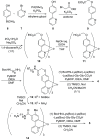

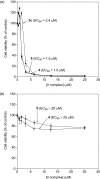
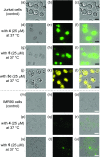
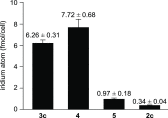




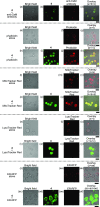

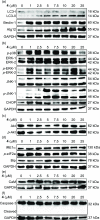
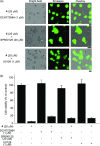


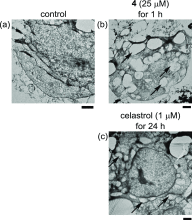

Similar articles
-
Induction of Paraptotic Cell Death in Cancer Cells by Triptycene-Peptide Hybrids and the Revised Mechanism of Paraptosis II.Biochemistry. 2024 Sep 3;63(17):2111-2130. doi: 10.1021/acs.biochem.4c00085. Epub 2024 Aug 14. Biochemistry. 2024. PMID: 39140188 Free PMC article.
-
Induction of Paraptosis by Cyclometalated Iridium Complex-Peptide Hybrids and CGP37157 via a Mitochondrial Ca2+ Overload Triggered by Membrane Fusion between Mitochondria and the Endoplasmic Reticulum.Biochemistry. 2022 Apr 19;61(8):639-655. doi: 10.1021/acs.biochem.2c00061. Epub 2022 Apr 1. Biochemistry. 2022. PMID: 35363482 Free PMC article.
-
Cyclometalated Iridium(III) Complex-Cationic Peptide Hybrids Trigger Paraptosis in Cancer Cells via an Intracellular Ca2+ Overload from the Endoplasmic Reticulum and a Decrease in Mitochondrial Membrane Potential.Molecules. 2021 Nov 21;26(22):7028. doi: 10.3390/molecules26227028. Molecules. 2021. PMID: 34834120 Free PMC article.
-
Intracellular Ca2 + Imbalance Critically Contributes to Paraptosis.Front Cell Dev Biol. 2021 Jan 12;8:607844. doi: 10.3389/fcell.2020.607844. eCollection 2020. Front Cell Dev Biol. 2021. PMID: 33585447 Free PMC article. Review.
-
IP3 Receptor-Mediated Calcium Signaling and Its Role in Autophagy in Cancer.Front Oncol. 2017 Jul 5;7:140. doi: 10.3389/fonc.2017.00140. eCollection 2017. Front Oncol. 2017. PMID: 28725634 Free PMC article. Review.
Cited by
-
Targeting paraptosis in cancer: opportunities and challenges.Cancer Gene Ther. 2024 Mar;31(3):349-363. doi: 10.1038/s41417-023-00722-y. Epub 2024 Jan 4. Cancer Gene Ther. 2024. PMID: 38177306 Review.
-
Types of Cell Death from a Molecular Perspective.Biology (Basel). 2023 Nov 13;12(11):1426. doi: 10.3390/biology12111426. Biology (Basel). 2023. PMID: 37998025 Free PMC article. Review.
-
Post-complexation Functionalization of Cyclometalated Iridium(III) Complexes and Applications to Biomedical and Material Sciences.Top Curr Chem (Cham). 2022 Aug 10;380(5):36. doi: 10.1007/s41061-022-00401-w. Top Curr Chem (Cham). 2022. PMID: 35948812 Review.
-
Induction of Paraptotic Cell Death in Cancer Cells by Triptycene-Peptide Hybrids and the Revised Mechanism of Paraptosis II.Biochemistry. 2024 Sep 3;63(17):2111-2130. doi: 10.1021/acs.biochem.4c00085. Epub 2024 Aug 14. Biochemistry. 2024. PMID: 39140188 Free PMC article.
-
Induction of Paraptosis by Cyclometalated Iridium Complex-Peptide Hybrids and CGP37157 via a Mitochondrial Ca2+ Overload Triggered by Membrane Fusion between Mitochondria and the Endoplasmic Reticulum.Biochemistry. 2022 Apr 19;61(8):639-655. doi: 10.1021/acs.biochem.2c00061. Epub 2022 Apr 1. Biochemistry. 2022. PMID: 35363482 Free PMC article.
References
-
- Dedeian K.; Djurovich P. I.; Garces F. O.; Carlson G.; Watts R. J. A new synthetic route to the preparation of a series of strong photoreducing agents: fac-tris-ortho-metalated complexes of iridium(III) with substituted 2-phenylpyridines. Inorg. Chem. 1991, 30, 1685–1687. 10.1021/ic00008a003. - DOI
-
- Flamigni L.; Barbieri A.; Sabatini C.; Ventura B.; Barigelletti F. Photochemistry and photophysics of coordination compounds: iridium. Top. Curr. Chem. 2007, 281, 143–203. 10.1007/128_2007_131. - DOI
-
- Omae I. Application of five-membered ring products of cyclometalation reactions as sensing materials in sensing devices. J. Organomet. Chem. 2016, 823, 50–75. 10.1016/j.jorganchem.2016.09.008. - DOI
LinkOut - more resources
Full Text Sources
Miscellaneous

